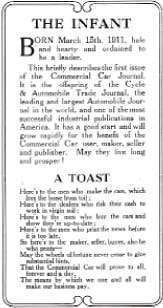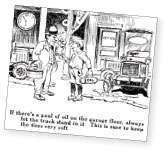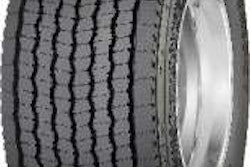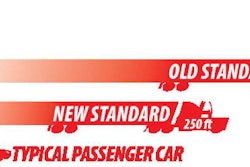CCJ 100
The first in a series of quick peeks into the world of commercial vehicles through the lens of Commercial Carrier Journal
Retrospective 1911 – 1919
By Avery Vise

CCJ launched on March 15, 1911, as the third publication in the market; the other two were Power Wagon and Commercial Vehicle – both long gone. CCJ’s publisher announced what amounts to a statement of principles. “The pages of the Commercial Car Journal are sacred and must be as nearly pure as can be made, so that there will be established a complete understanding and confidence between subscribers and advertisers.”
Where were the Clydesdales?

Tackling the first technology debate
Gasoline or electric? Gasoline or diesel? Worm drive or chain drive? Pneumatic tire or solid tire? Cabover or conventional? Air disc or drum? Duals or singles? Satellite or terrestrial? Advanced exhaust gas recirculation or selective catalytic reduction?
These are just a few of the many technological choices fleet owners have faced over the past 100 years. But during its first decade – and for a number of years thereafter – CCJ addressed the original technology choice: truck or horse?
When CCJ launched in 1911, commercial trucks were very much in the minority. For example, a January 1910 estimate put the number of horse-drawn commercial vehicles in New York City at 231,000, while registration figures showed 783 motor vehicles in use by 274 owners.
While the publisher and editors of CCJ thought the choice was obvious, companies operating delivery or work vehicles didn’t. After all, a horse was much cheaper than a commercial truck, which could run from $2,000 to $4,000. But once you got past acquisition cost, the truck shone, CCJ preached.
“When contemplating the purchase of a motor-propelled delivery wagon or truck, it is well to remember that one cannot compare the cost of horses and wagons with commercial vehicles in a general dollar-and-cents manner,” the publisher wrote in the Sept. 15, 1911 issue. “Pens and ink cost less than typewriters, but you would consider it expensive to have your business letters handwritten … . Men say that time is money – and yet many use horses.”
CCJ truly went on the offensive as summer months approached, pointing out how inefficient horses were when temperatures soared. Citing Society for the Prevention of Cruelty to Animals guidelines, the magazine noted that when temperatures were high, horse drivers must seek shade. Horses’ loads must be reduced during hot summer weather, they must stop frequently for water, and they might need to be bathed in cold water and given a half-hour’s rest. “Can you, as a business man, be bothered with such petty troubles?”
The magazine highlighted many various applications in which commercial trucks had been shown to be more productive, reliable and durable than horse-drawn vehicles. CCJ punctuated its anti-horse crusade with frequent illustrations and editorial cartoons – not all of which made much sense. For example, one shows a driver falling asleep, loosening the reins on the horse. Chaos ensues when the horse strikes the awning of a building. OK, but if a truck driver fell asleep, would the result have been better?


The Driver’s Code from the Owner’s Viewpoint
FSF

Brands that last


Visit www.CCJ100.com for an in-depth timeline detailing news and events in the trucking industry from this decade and share your company’s history. You also can read about a recent test drive of an actual 1915 International truck.












